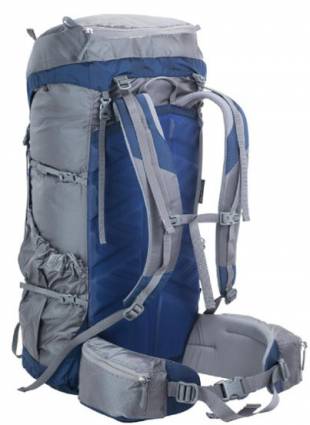My Personal Desired Backpack Features
- 34L to 40L, narrow (tall)
- Minimal internal frame without Osprey Exos exaggerated curvature and strung mesh
- Detachable daypack brain
- Deep mesh side pockets like the Exos
- Side compression straps like the Exos
- Hip Belt pockets
- Shoulder Strap Pocket like the Osprey Talon
- Internal hydration sleeve
- Gear loops
- Attachment points or elastics/straps for piggybacking added volume
- Tall fully zippered front pocket with organizer like the Kelty Pawnee 40 (optional)
- Rain cover stow pocket like the Kelty Pawnee 40 (which also stows the power bank for the solar panel)
I don't understand why people need more than a 40 liter backpack. I have carried two weeks of equipment and provisions in the Kelty Pawnee 40 (not included in list below because it weighs 51 oz). Granted, it takes some finessing and the top is extended beyond normality, but only because I carry way more toys than I should. As the hike goes on, the pack returns to normal size as food gets eaten.
I tend to favor smaller volume equipment, even over weight savings. Someday I may try losing 2 lbs of weight by getting a lighter backpack, but for now I am perfectly content with the Pawnee, because it has all the features I like (except for waterproof fabric), and because my ideal backpack does not exist. An advantage to a 40 liter or less pack is that you have the highest chance of not needing to check the bag when flying on an airplane.
Update: I may look into using a waterproofing spray on the outside of the pack. The coating will surely weigh less than the pack cover.
Many backpack manufacturers have taken to include the volume of expanding mesh pockets as part of the overall declared volume of the pack. The main chamber of the Zpacks Arc Air 50 is 37 liters, and the rest of the counted volume is in the expandable mesh pockets.
Dyneema is a super-lightweight and waterproof material used in expensive backpacks. By contrast, traditional nylon backpacks are waterproofed internally, but the exterior can absorb water, making the pack heavier during rain unless a pack cover is used. A backpack with Dyneema does not require a raincover.
The only Dyneema backpacks that I know of are made by Zpacks. To save weight, Zpacks do not have a full internal frame, lacking a barrier to keep items in your backpack from jutting out towards your back. Instead, the arc of the backpack keeps any edges from coming in contact with your skin.
I look forward to a full internal frame pack, perhaps made of carbon fiber, with contour shaped Dyneema fabric (rather than the current ugly tubes) with all the features that got left behind in the current UL stint. Instead of 19 oz barebone Zpack, I would have a much nicer pack that is maybe 30 oz. More like the Gregory Optic or REI Flash pictured below, or the Exos with hip belt pockets (although 2017 Exos 58 had them). Maybe the only change needed would be to convert their fabrics to Dyneema?
Maybe I just need to look for products where USA is not the focus of advertising/marketing (see European options below). Maybe there are alternatives to Dyneema, like X-Pac. Dyneema vs X-Pac: Ultralight Fabrics, Janis Lacey carryology.com 20171026.
Osprey Exos 38 (40 oz)
Osprey Levity 45 (28 oz)
Gregory Optic 48 (40 oz)
REI Flash 45 (40.5 oz)
Zpacks Arc Air 50 (19 oz)
Photos below of the Gregory Optic 48 and the REI Flash 45.


Backpacks that already meet most requirements and are more lightweight are the Granite Gear 38 (33.5oz, 26oz without the pocketed brain lid) and the Drop 40 (32 oz, no brain). Instead of a cool looking formed body, they have a boyish figure.


Frameless packs from Granite Gear are:
Granite Gear Virga 2 54 (19 oz) frameless
Virga 26 (12 oz) frameless
Related article: Why You Don’t Want or Need an Ultralight Backpack, Wes Siler outsideonline.com 20170610
European Backpacks
Montane Halogen 33 (32oz)
Montane Azote 32 (33oz)
Montane Naukan 60 (32oz)
Terra Nova Laser 35 (495g 18oz) ←- video watch 2x speed or die of boredom
PajakSport XC3 45 (600g 21oz) ←- video of much older 2012 model
More…
https://alpkit.com/collections/backpacks
https://www.crux.uk.com/category/alpine-rucksacks
https://summiteerequipment.com/collections/rucksacks
https://liteway.equipment/packs
Source: https://www.reddit.com/r/Ultralight/comments/eotdv9/ul_backpacks_in_eu